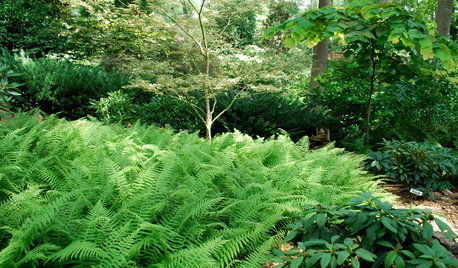March 15, 2007
In the Garden
The Dark Side of a Good Friend to the Soil
By ANNE RAVER
IVE always thought of worms as my friends, until I started talking to ecologists who have been studying their voracious appetite for leaves.
"Your grandmother was wrong all these years," said Dennis Burton, an ecologist at the Schuylkill Center for Environmental Education in Philadelphia.
Worms may be good for vegetables and flowers, but for trees and shade plants they are a large and growing menace. In an agricultural field or a vegetable garden, worms help decompose organic matter, churning nutrients back into the soil. Their constant tunneling aerates the soil, creating pathways for air, water and plant roots.
But in forests in the Northeast and parts of the Midwest, worms are proliferating and consuming leaves at such a pace that they are actually destroying the duff, the thick leaf litter that nourishes tree seedlings, prevents erosion and protects woodland plants from disease and insects.
They are wreaking havoc in woodland gardens, too. Barbara and Robert Tiffany, who tend four acres of shade-loving plants at their home, MillFleurs, in Point Pleasant, Pa., have watched their prize-winning, four-foot-wide hostas shrink to half their size.
The Tiffanys first noticed that their hostas were shrinking two years ago. This was a crisis: they had promised to show off their 1,100 hosta cultivars to the American Hosta Society at its national convention last June in Philadelphia.
"I had no idea what was happening," Ms. Tiffany said.
They thought their water might be the problem, so they had it tested. But the water was fine. Then they noticed "gazillions of worms," Ms. Tiffany said. "Every time I would stick a trowel into the soil, worms would pop up or skitter away. They were so energized, not like the worms of my childhood."
Mr. Tiffany did a little research and learned that the Northeast and the Great Lakes region were plagued by worms. They sent a few of their worms to Cindy Hale, a scientist at the University of Minnesota, who identified them as Amynthas hawayanus and Lumbricus terrestris, two species that are invading the Northeast.
The Tiffanys realized, in retrospect, that they had been helping the worms proliferate by carting in mulch for paths and top-dressing plants with compost.
They recalled digging up one prized hosta, a four-footer that had been reduced to two feet, and counting 19 worms as they fell from its roots.
The roots, normally so fleshy and vigorous, were stunted and sort of shredded, "as if something had eaten them," Ms. Tiffany said.
"Earthworms were not meant to be in a forest," said Anne Bower, a conservation biologist at Philadelphia University who explained that northern forests evolved without worms. "Their decomposers are fungi, microflora and fauna, which release nutrients very slowly," she said.
Worms arrived with the Colonists, who came in ships often weighted with rocks and soil, for ballast. The settlers brought plants, too, which carried worms and their eggs in plant roots. Over the centuries, of course, imported plants added to the exotic worm population; so did the fishermen who tossed their bait worms along the banks of streams and lakes.
In fact, the night crawler, Lumbricus terrestris, native to Europe and a favorite for baiting fish, is a big eater in the forest.
"ItÂs an anecic species, a deep diver," Mr. Burton said. "It burrows deep into the soil, pulling leaf litter with it."
Another invasive worm, an Asian species, Amynthas hawayanus, is epigeic, meaning it stays close to the earthÂs surface, living in the topsoil and the duff layer.
"ItÂs like a rototiller running around the surface of the forest," Mr. Burton said.
Both these worms, among others, have higher populations in urban and suburban areas than in rural areas. This makes sense, because they first came in through seaports and are often spread by gardeners who not only purchase their plants but also trundle mulch and compost into their woodland gardens.
The Asian genus, Amynthas, was first noted in New York and Connecticut in the late 1980s by ecologists working for the Institute of Ecosystem Studies in Millbrook, N.Y. They were trying to analyze the health of forests in a 100-mile radius of New York City.
These worms change the very chemistry of the soil, because their gizzards emit calcium carbonate, which acts like lime on acid soil, making it more alkaline. That may be nice for corn and sunflowers, but it is not good for azaleas and oaks, which thrive in acid soil.
The worms are also breaking down organic matter so quickly that the nutrient overload is injuring plants and running off into streams and lakes. Invasive plant species, like stiltgrass and garlic mustard, which thrive on heavy nitrogen, then move in.
How do you find out if you have too many worms?
Look for signs of invasive worms, such as a thinning forest floor or even eroded open spaces. Another sign is a noticeable lack of spring ephemerals like trillium, mayflowers and trout lilies, which are disturbed by all these tiny plows shifting the microbial community from fungal to bacterial.
To test for worms, mark off a section of your woodland garden or forest about three feet square. Then wait for a heavy rain (this test will not work in dry soil).
If the soil is moist, apply a hot Chinese mustard solution, made by mixing two cups Chinese mustard with 10 ½ quarts of water. Sink five coffee cans, tops and bottoms removed, about an inch into the ground of the marked area, then pour the mustard solution into the cans.
"The mustard solution will go straight down and the worms will come up," Ms. Bower said.
If more than five worms pop out, you have a problem. In rural areas Ms. BowerÂs researchers have found only about two worms per three square feet; "in the city weÂre getting 89," she said.
Ms. Bower and Mr. Burton have been testing various organic controls, like tobacco, walnut shells and pine needles. They were not effective. Sulfur pellets, however, mixed with oak leaf mulch, which is acidic, showed promise. Simply follow the directions on the back of the sulfur bag, and do not apply more than is recommended. (Soil that is too acidic will have its own problems.) Then spread out a couple of inches of the oak leaf mulch. The Department of Agriculture lists earthworms as beneficial organisms, so using a pesticide to kill them is technically illegal.
To avoid having so many worms in the first place, be sure not to feed them by spreading wood chips or compost in paths in the forest. Do not toss grass clippings, another favorite worm food, next to the woods, either. And do not toss out fishing worms or red wrigglers by throwing them on the ground or in a pond (they do not drown).
If worms are destroying your woodland plants and you have no choice but to kill them, they can be put in alcohol, frozen or collected in a bag and sent to the landfill.
Copyright 2007 The New York Times Company














scuba-gal
pjtexgirl
Related Discussions
Good soil mix for repotting Indoor Jade plant (2-3 feet tall)
Q
Good Soil Health = ?
Q
Getting good soil for new garden beds
Q
What good detergent that can be used for minimally soiled clothing?
Q
jolanaweb
pricklypearsatx
prairiepaintbrush
carrie751
stitches216
denisew
fliptx
lindseyrose
prairiepaintbrush
TXChickadee